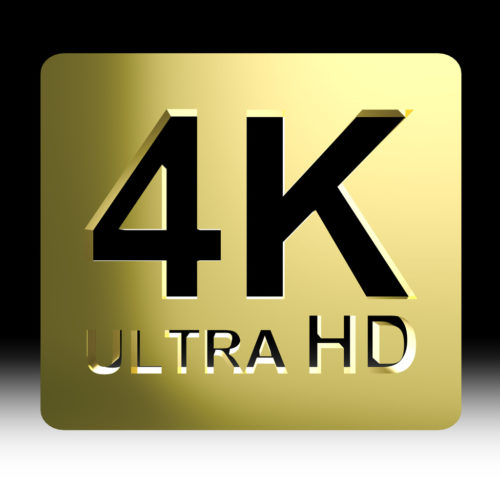We are often asked questions about resolution, and most recently, about 4 K resolution in reference to television. We know quite a few people who are buying a new large screen television for the holidays, as a family gift. New technology always provokes questions and since we are professional videographers and photographers, we are not surprised at the questions. 4K Resolution is a big buzzword in the television market. Yes, 4K resolution and a pixel parade on the way to your living room and your television set.
You are in for a shock if you are still impressed with the clarity of HD. Yes, there’s a new sheriff in town, and “his” name is 4K. If HD and all its pixels impressed you, just wait until you see 4K resolution.
4 K Resolution: Time for a Definition

4K Resolution Means Ultra Watching Pleasure
4 K has a sweet alias: “Ultra HD.” Thus, whether you call it Ultra HD or 4K, or, as in the overstatement of some brands, 4K Ultra HD, this resolution “has enough pixels to fill four Full HD 1080p screens. With four times the amount of pixels it’s able to display four times the level of detail.”
Nowhere is this more obvious than in today’s big-as-life flat screen television, 50 inches and above. So, if you are planning to buy a nice big flat screen TV for the family, be ready to buy a 4K. (Besides, pretty soon manufacturers won’t give you much of a choice. So, find out the basics of this pixel parade now.)
Let’s do the math.
1. Traditional HD is 1910 vertical columns and 1080 horizontal rows of pixels.
2. However, 4K or Ultra HD has a total resolution of 3840 pixels by 2160.
3. And this is only a few less pixels than Cinema 4K, which you see at the movie theatre.
4. Since we brought it up, we had better inform you that Cinema 4K boasts 4,096 a slightly smaller resolution than the 4,096 x 2,160.
To put it simply, 4K means a clearer picture. In fact, it is 8,294,400 pixels to be exact, marching out on the screen. That means images that are loaded sharpness and detail that surpass HD.
5. Family Movie Night just got better with 4K (Ultra HD.)
Visualizing the 4K Difference
If the numbers aren’t impressive enough, let’s make it visual. “Think of your TV like a grid, with rows and columns. A full HD 1080p image is 1080 rows high and 1920 columns wide. A 4K image approximately doubles the numbers in both directions, yielding approximately four times as many pixels total.” So the entirety of a picture on your 1080 p or regular HD screen could all fit into one quarter of a 4K screen.
A Note about Nomenclature: You might also notice, as you shop for your new television, that the industry termed:
- 1080 resolution after the image height.
- However, they have named 4K after the image width.
- And yes, some people might refer to 4K as 2160p. However, that’s okay, because now you know.
And you probably already know that pixels carry information. So, since you get more information in a 4K image, the result is a sharper picture.
We know a few people who must get the feeling of stepping right into their TV screen. Whether it’s a movie or a football game, they want to be totally immersed in the visual experience. If you are one of those people, then that crisp, sharp 4K resolution is your ticket to transformation. And it is not just because 4K resolution parades all those pixels. There are bonuses included with most 4K televisions. These bonuses do as much for your viewing experience as the actual 4K technology.
4K Resolution Comes With Bonuses

4K Ultra HD in a Big Screen TV Can Give You a Totally Immersive Experience
A big screen television with 4K Resolution is worthy of the price, not just because of the pixel parade, but because of the “good stuff” manufacturers put with it.
Business Insider says, “The price reduction for 4K TVs also makes regular 1080p HD TVs much cheaper as well, but that’s not really a good thing. Basically, it means that the really important stuff that makes up a good TV display —
- higher contrast ratios
- smoother motion,
- and better colors, for example — has been stripped out of 1080p TVs to cut costs, and put into 4K TVs instead.”
4K Bonus Feature One: HDR
Although 4K has stolen most of the hype, the televisions with it also feature HDR. High Dynamic Range, which boosts the contrast ratio. Contrast ratio is the difference between the brightest and darkest colors your TV can show.
HDR boosts a display’s contrast ratio, which is the difference between the brightest and darkest colors your TV can show. It permits much finer detail in the all the shades in between those light and dark colors.
4K Bonus Feature Two: WCG
Such televisions also typically boast WCG. This technology, Wide Color Gamut, (WCG), permits a TV produce so many more colors, hues and shades that the range exceeds the capacity of the display.
“The combination of 4K, HDR and WCG results in a picture that’s more vivid and lifelike. Colors are less muted, and objects appear to have more depth. It’s not a gimmick, but a real improvement to picture quality.”
A Unique Recommendation for Immersive Video Experience in the 4K Television World
Experts at Techradar.com are advising you to move your couch closer to your big screen, 2K Television for the most powerful effects. They report, “The ability to get up close to the screen without the image breaking down is one of the most intoxicating things about 4K.” So if you sit closer to the big screen, that same sized screen actually fills more of your visual field. Then you have greater immersion in your television experience.” Tom’s Guide, states that, “Basically, if you can see the individual pixels of the screen, you’re too close. A good rule of thumb is that you should sit at a distance from the TV that is three times more than the height of the screen for HD and just 1.5 times the screen height for 4K Ultra HD. In other words, you can sit twice as close to a 4K UHD TV.”
And now you understand why 4K computer monitors have become one of the technology’s fastest growing sectors. With a 4K monitor, if you are just a foot or two away from the screen, the images remain crisp and tack sharp.
One Final 4 K Resolution Caveat
To get the greatest effect from your 4K television Set, you must have 4K programming, and you might as well know that does not include programing from ABC, NBC, or CBS. However, there are plenty of alternatives.
“4K content is now freely available on many streaming services and on Ultra HD Blu-ray discs, even if it hasn’t been adopted by broadcast or cable TV services yet. If you have a very fast internet connection, you can watch some excellent shows on Amazon and Netflix in 4K (and most new original programming on the services is being produced at that resolution).”
Likewise, “New films are also coming out digitally in 4K through various on-demand streaming services like Vudu.” We must add Hulu to this list; they recently touted twenty available James Bond movies in 4K Ultra HD.
Get Red Hot New Blu-ray Disks in 4K Ultra HD

Family Fun is Enhanced with Big TV and 4K Resolution
4K Ultra HD Blu-ray discs are the latest physical media format. Yes, they are similar to Blu-ray discs, but you cannot play them on your regular old Blu-ray player. Experts advise you to shop for a dedicated Ultra HD Blu-ray player for the 4K format.
Happily, the dedicated Ultra HD Blu-ray player also stores 4K video with HDR. Plus, if you have the appropriate speakers, it plays advanced surround sound. You do not even need Internet connection for such disks because Ultra HD Blu-ray discs are, of course, physical media format.
We hope these explanations help you in your next television-buying journey. Family movie nights are a great tradition, and 4 K makes the adventures even better. BullHorn Media says, don’t forget the popcorn!
And don’t worry about 8K. Yes it is coming and yes, it is rich. No worries for you. It is designed for commercial display. And perhaps that will be in a future blog.


